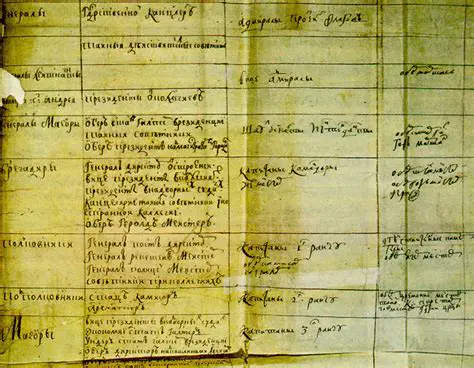Introduction

Peter the Great, the visionary emperor who ruled Russia from 1682 to 1725, implemented a groundbreaking policy known as the Table of Ranks, which profoundly shaped Russian society and governance. This comprehensive system established a hierarchical structure for civil and military service, with ranks based on merit, service, and loyalty. The Table of Ranks became a cornerstone of Peter’s modernization efforts, creating opportunities for social mobility and meritocracy in a society previously dominated by hereditary privileges.
Historical Context
Prior to the Table of Ranks, Russian society was rigidly stratified, with the elite boyar aristocracy holding most positions of power. Peter, recognizing the need for a more efficient and merit-based government, sought to打破 this status quo and create a system that rewarded talent and service.
Key Features of the Table of Ranks
The Table of Ranks was a detailed document that outlined the hierarchical structure of government, military, and civil service positions. It was divided into 14 ranks, each with its own privileges and responsibilities. Advancement through the ranks was based on:
- Merit: Individuals were rewarded for their achievements, qualifications, and competence.
- Service: Years of service contributed to rank advancement.
- Loyalty: Loyalty to the throne and the state was highly valued.
Ranks were classified into three categories: military, civil, and court. Military ranks ranged from Private to General-Field Marshal, while civil ranks included Titles such as Secretary, Councillor, and Senator. Court ranks, such as Chamberlain and Master of Ceremonies, were reserved for those who served in the royal household.
Impact and Legacy
The Table of Ranks had a profound impact on Russian society:
- Social Mobility: It created new opportunities for social advancement for talented individuos, regardless of their social origin.
- Meritocracy: It introduced the principle of meritocracy, rewarding individuals based on their abilities and contributions.
- Modernization: The system helped to modernize Russia’s government and military, making it more efficient and effective.
- Expansion of Bureaucracy: The Table of Ranks led to the expansion of the bureaucracy, as more positions were created to meet the needs of a growing and complex state.
Motivations and Challenges
Peter the Great’s motivations for implementing the Table of Ranks were multifaceted:
- Need for Modernization: He recognized the need to reform Russia’s antiquated governance system to keep pace with Western Europe.
- Desire for Control: By creating a system of merit-based advancement, Peter aimed to reduce the power of the traditional boyar elite and consolidate his own authority.
- Shortage of Skilled Personnel: Russia lacked a sufficient number of qualified personnel to fill key positions, and the Table of Ranks provided a mechanism for attracting and developing talent.
However, the implementation of the Table of Ranks was not without its challenges:
- Resistance from the Elite: The old elite resisted the erosion of their privileges and power, creating obstacles to the policy’s full implementation.
- Limited Education and Training: The lack of widespread education and training opportunities made it difficult for many individuals to qualify for higher ranks.
- Bureaucratic Inefficiency: The expansion of the bureaucracy led to increased red tape and inefficiency, which sometimes hindered the smooth functioning of government.
Effective Strategies
Peter the Great implemented several effective strategies to ensure the success of the Table of Ranks:
- Mandatory Education: He made education compulsory for all children of noble birth, ensuring a supply of qualified individuals for government service.
- Foreign Experts: He hired foreign experts to train Russian officials and introduce modern administrative practices.
- Strict Enforcement: He actively enforced the Table of Ranks, punishing those who tried to bypass its requirements.
Tables
Table 1: Military Ranks
| Rank | Description |
|---|---|
| Private | Lowest rank in the military |
| Sergeant | Non-commissioned officer |
| Lieutenant | Commissioned officer |
| Captain | Commands a company |
| Colonel | Commands a regiment |
| General | Commands a brigade or division |
| General-Field Marshal | Highest military rank |
Table 2: Civil Ranks
| Rank | Title |
|---|---|
| Secretary | Lowest civil rank |
| Councillor | Mid-level civil servant |
| Senator | Member of the Senate |
| Minister | Head of a ministry |
| Chancellor | Highest civil rank |
Table 3: Court Ranks
| Rank | Description |
|---|---|
| Chamberlain | Attends the royal court |
| Master of Ceremonies | Organizes royal events |
| Grand Master of the Court | Highest court rank |
Table 4: Statistics on the Table of Ranks
| Metric | Value |
|---|---|
| Number of ranks | 14 |
| Number of military ranks | 7 |
| Number of civil ranks | 6 |
| Number of court ranks | 1 |
FAQs
Q: What were the main goals of the Table of Ranks?
A: The main goals were to promote social mobility, introduce meritocracy, modernize government and military, and expand the bureaucracy.
Q: How did the Table of Ranks affect Russian society?
A: It created new opportunities for social advancement, rewarded individuals based on merit, and helped to modernize the government and military.
Q: What challenges did Peter the Great face in implementing the Table of Ranks?
A: He faced resistance from the elite, limited education and training opportunities, and bureaucratic inefficiency.
Q: What strategies did Peter the Great use to ensure the success of the Table of Ranks?
A: He made education compulsory, hired foreign experts to train officials, and strictly enforced the policy.
Q: What is the legacy of the Table of Ranks in Russia?
A: The Table of Ranks became a cornerstone of Russian governance, establishing a hierarchical structure based on merit and service, which continues to influence the Russian government and society today.
